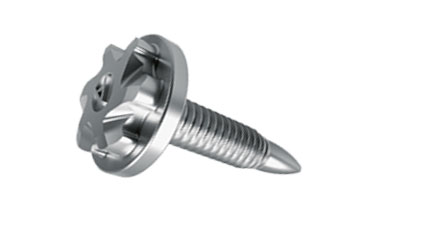Flowweld®
Friction element welding
Flowweld® – friction element welding from ARNOLD UMFORMTECHNIK starts where conventional joining processes used in the manufacture of vehicle bodies reach their limits. The joining process is distinctive for its fastening performance in difficult combinations of materials. The comprehensive system joins the fastening element securely and economically.
Benefits
Flowweld® joins lightweight metal components to maximum strength steel components. There are no limits to the steel component’s strength classification. All that is needed is that the steel material can be welded. The limiting variable on the procedure is accessibility of the joining point. If it is accessible, then any lightweight metal to steel fastenings can be made. Due to its higher specific tensile strength the use of high-strength steel is desirable. Using less material the material combination achieves the same or even better mechanical properties. For the automotive sector, energy efficiency is of extreme importance. Efficiency increases as drive technology, traction resistance and overall weight are optimised. The car body represents a major proportion of the overall weight. So saving weight is very important here. By reducing weight, combustion engine vehicles require less energy and this results in lower CO2 emissions. And electric cars see an improvement in range per battery charge.

Characteristics
The Flowweld® System offers new opportunities for vehicle body design. We developed our own system to bring the art of friction welding to perfection. The system is adapted to the geometry of the element to ensure a fast, reliable join.
Advantages
- Base plate thicknesses start at 0.8mm and strength classes up to 1900 MPa
- Cover material thicknesses available from 0.8 to 3.00mm with just two lengths of fastener element
- System technology designed especially for friction element welding
- Join direction aluminium to steel
- Hybrid material combinations can be achieved with adhesive
- Achievable flange widths, min 17.0mm
- Shearing strengths up to 12.0 kN
- Cross tension strengths up to 8.0 kN
Flowweld® – friction element welding from ARNOLD UMFORMTECHNIK starts where conventional joining processes used in the manufacture of vehicle bodies reach their limits. The joining process is distinctive for its fastening performance in difficult combinations of materials. The comprehensive system joins the fastening element securely and economically.

Characteristics
The Flowweld® System offers new opportunities for vehicle body design. We developed our own system to bring the art of friction welding to perfection. The system is adapted to the geometry of the element to ensure a fast, reliable join.
Benefits
Flowweld® joins lightweight metal components to maximum strength steel components. There are no limits to the steel component’s strength classification. All that is needed is that the steel material can be welded. The limiting variable on the procedure is accessibility of the joining point. If it is accessible, then any lightweight metal to steel fastenings can be made. Due to its higher specific tensile strength the use of high-strength steel is desirable. Using less material the material combination achieves the same or even better mechanical properties. For the automotive sector, energy efficiency is of extreme importance. Efficiency increases as drive technology, traction resistance and overall weight are optimised. The car body represents a major proportion of the overall weight. So saving weight is very important here. By reducing weight, combustion engine vehicles require less energy and this results in lower CO2 emissions. And electric cars see an improvement in range per battery charge.
Advantages
- Base plate thicknesses start at 0.8mm and strength classes up to 1900 MPa
- Cover material thicknesses available from 0.8 to 3.00mm with just two lengths of fastener element
- System technology designed especially for friction element welding
- Join direction aluminium to steel
- Hybrid material combinations can be achieved with adhesive
- Achievable flange widths, min 17.0mm
- Shearing strengths up to 12.0 kN
- Cross tension strengths up to 8.0 kN



